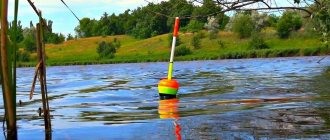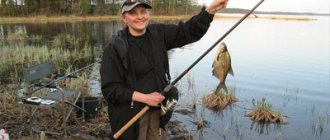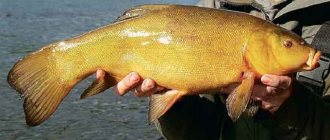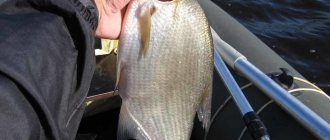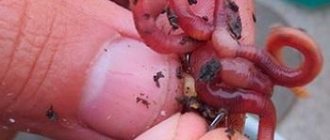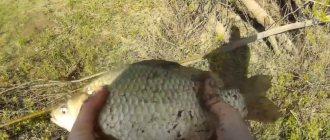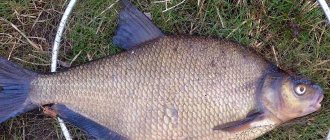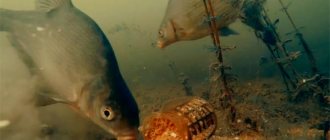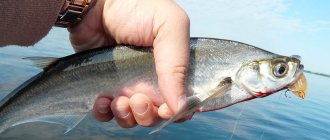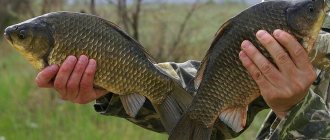Gear selection
Bream should not be underestimated. With a weight of 3-4 kg, it is considered a fairly large fish, so you should not neglect the choice of gear for catching bream on a feeder.
- Rod. The optimal rod is a length of 3.5 meters, class - heavy, test - up to 90 grams. But, first of all, it depends on the reservoir. Catching bream on a feeder at the mouth of the river will require a rod up to 4-4.5 meters long, with a weight of up to 120 grams (extra heavy class). When fishing on a river with a narrow channel, it is more rational to use a light and durable fishing rod up to 3 meters long (2.2-2.7 meters).
- Coil. A regular spinning spool, a deep spool, up to 4000. Fishing with a feeder involves a high load on the reel, so it is better to take a model with 3 or more bearings. The location of the clutch doesn’t really matter; the main thing is to set it up correctly so as not to tear the fish’s mouth when hooking. Gear ratio – 4-6.
- Main line. Both monofilament (thickness 0.2-0.22 mm) and woven (thickness 0.12-0.14 mm) are used. It is more rational to use braid, which is less noticeable in water and much stronger than monofilament. The lack of stretch makes it more convenient to cast the feeder. This is important, since bream fishing with a feeder is usually carried out at a great distance from the shore.
- Leashes. Without hesitation, you can use a fishing line up to 0.2 mm in diameter - large bream are not particularly shy, but strong enough to break a leash that is too thin. The length is determined experimentally directly during fishing, and can range from 20 to 100 centimeters.
- Hooks. No. 10-14 international size chart, hardened, high quality. Such hooks make it possible to use a large bait without breaking or bending under the weight of a large specimen.
Tip: When fishing for bream in a current, it is advisable to have with you removable rod tips of different hardness: a soft one bends in a strong current and does not show a bite, and a hard one loses sensitivity in a weak current and in standing water.
Tackle for catching bream on a feeder in the current
To catch bream on a feeder, select a rod with a length of at least 3.6 meters and a weight of no more than 90 grams. It is better to choose a reel with a bullet size of about 3000. The choice of rod length is determined by the size of your pond, up to 4 meters. On small rivers that are heavily overgrown with vegetation, you can use a rod no more than 2.7 meters.
The choice of fishing line for catching bream on a feeder is also determined depending on the recommendations of the rod supplier. The most commonly used tensile strength is around 10 pounds. Instead of fishing line, you can use a twisted cord.
Leashes can be selected in diameter from 0.12 to 0.2 mm, depending on fishing conditions. When using a shell as a bait, it is better to take a stronger leash. The length of the leash must be determined experimentally. Since bream is a very cautious fish, they start with a length of about 50 centimeters. If there are no bites, increase the leash gradually, up to 1 meter. With an active bite, as well as with a deep throat of the hook, you can stop at 25 cm.
The size of the feeder for catching bream is better to take a medium one, square in shape, with a weight of up to 70. You can increase the weight of the feeder to 90 grams if the current is very strong. The hook size can range from size 14 to size 10. An asymmetrical loop should be used as equipment.
A quivertip bream feeder must have at least three interchangeable tips, designed for different current strengths and weights of feeders (light, medium, heavy).
In a fast current, the soft tip immediately bends, so it reacts poorly to a bite; and a tip that is too rigid in a weak current will be insensitive.
The optimal color of the tips is orange - the eyes don’t get so tired. The use of a feeder of one weight or another largely depends on the strength of the current. The choice of volume and weight of the feeder also affects the choice of fishing rod.
To catch bream on a feeder, two types of feeders are used - open and closed. When fishing in the current, flat feeders are convenient - they lie securely on the bottom. Sometimes, on dug-out soil, rolling equipment based on an open conical or oval feeder for plant food is used.
On rivers, it can be effective to use a tandem of feeders, one of which is closed for live food, and the other open for plant food. However, in October you already need to use a feeder intended only for live food - bloodworms, maggots.
Sometimes bream comes out to feed in deep pools. A non-lead feeder filled with loose food that sinks slowly, emitting an attractive trail of bait, may be suitable here.
Feeder equipment
The equipment is selected in such a way that the bites are visible as clearly as possible. The bream bites very carefully and can abandon the bait at any time. Catching bream on a feeder will be successful if you choose the right tying method, which depends on the characteristics of the reservoir. The most catchy ones are:
- Gardner's loop (paternoster) - is distinguished by its simplicity of knitting, accessible even to a novice fisherman. Easily manufactured directly on site. Many fishermen consider it the most versatile when fishing for bream with a feeder. The main advantage is high sensitivity, thanks to which the angler notices the slightest touch of the bait by the fish.
- Asymmetrical loop - good for fishing in currents. When bitten, the feeder remains in place, and the angler can accurately track every movement of the fish.
- A symmetrical loop is optimal when fishing in reservoirs with standing water.
- Helicopter - there is no self-hooking with this method of mating, so you will have to monitor the bites very carefully. The advantage is that a long leash with a hook lowers slower than the feeder, giving the fish more time to notice the bait. The length of the leash depends on the depth of the layer in which the largest amount of fish is concentrated and can change during the fishing process.
The choice of feeder depends on the pond and time of year.
- Reticulate (“cells”). Used throughout the summer and early autumn. The shape depends on the body of water. In case of strong currents, feeders with a flat bottom that are not carried away by water are optimal. The same ones are used on reservoirs with muddy bottoms. Oval and cone-shaped feeders are suitable for catching bream on a feeder in still water.
- Closed. They look like a cylinder with small holes and are filled with animal feed. They are used in the fall, when bream prefers animal food - maggots, bloodworms.
- Springs. Such feeders are used infrequently, mainly in closed reservoirs.
The choice of feeder may vary depending on the preferences of the fish and fishing conditions in a particular body of water.
Adviсe:
- When fishing for bream in deep backwaters, it is better to take feeders without a lead-weighted bottom - they slowly sink in the water, spreading the bait and attracting the attention of the fish.
- When catching bream with a feeder on the river, it is recommended to combine open and closed feeders - for plant and animal bait, respectively.
Where to catch bream on a feeder
To choose a place to catch bream on a feeder or bottom, you need to know where bream schools live, when and what they feed on. These fish avoid fast currents and stick to calm waters. In addition, this is a cautious fish and chooses deep places for its permanent residence. It is correct to catch them where they live permanently, and not where they go for walks, since this fish is very lazy and comes out of the pits inconsistently and only when there is a lack of food or when the weather changes.
And if you managed to find a place for bream, then when catching bream on a feeder or bottom, it is always better to use feeders with bait. It’s also better to feed the fishing spot in advance; it happens that sometimes you have to feed for several days in one place, but the probability of catching a trophy specimen will be much greater than without bait.
This fish can be caught during the day, but not often; when fishing during the day, you need to take into account the position of the sun. If you catch it from a boat, then you need to stand on the boat and stay so that the sun is in front or to the side, but not behind, so that the shadow does not fall on the fishing spot, since the fish is very careful and does not come close to the shadow.
However, in the spring on the river, when schools of bream are walking, they are sometimes caught in not very deep places with a flat sandy bottom, and of course with bait. The largest individuals are usually found near steep clayey shores in holes and pools. In general, this fish needs to be looked for, and if the fishing spot is not known to the fisherman thoroughly with its depths, then it is better to use an echo sounder, more to determine the depths than to search for fish.
However, after spawning in late spring and early summer, bream usually bites on the feeder in the morning, but not in the very early morning, but from 6-7 am. And when the grass is already growing, they take large specimens only early in the morning, before sunrise, and also peck at sunset, very late in the dark. It’s better to catch them on quiet and warm nights and especially during the full moon.
In summer, the phases of the moon greatly influence the lifestyle of these fish; it is noticed that the bite also stops when the new moon appears. Probably during the new moon and the first quarter, the fish come out of the holes in the shallows and catching bream on a feeder in holes and pools is less successful, and it is better to try to catch bream with a float rod or bottom tackle in shallow places.
Bream, like many other fish, are sensitive to changes in atmospheric pressure. Before bad weather, the barometer pressure drops, and they completely stop being caught with a fishing rod, feeder or donk, because they lie in holes and even bury themselves in silt. And also these fish stop catching when the northeast or north wind blows. The water level also affects the fish’s bite; they only take in low and medium water, but in the profit of water, after heavy rain, and during floods, in the summer bream on the feeder not only stop being caught, but even temporarily leave their holes. When the water recedes, they return to their summer camps.
In the heat of summer, before a thunderstorm, as well as on cloudy and windy days, they rise to the top, only to then hide in the depths again. Rising from the depths, the fish first sticks its muzzle out of the water, then its dorsal fin, and then its tail, which it throws to the side sometimes with a splash. This also happens in shallows, but more at night. Usually in rivers in aquatic thickets, schools of bream can be identified by the loud swishing or smacking sounds made by their mouths, so they suck on the upper, young shoots of plants, as well as the roots of duckweed.
Fishing for bream on a feeder or donka in open water begins in early spring in April, as soon as the ice melts and in May. But the early spring bite in May before spawning is short-lived, although fish that have become hungry during the winter take very well, and fishing can be very productive. After spawning, having eaten enough, they stop taking fish for a month or more, sometimes getting caught on windy, cloudy or thundery days.
Bream begin to bite on the feeder in the summer from mid-July, and in the north already in August, when they already begin to flock into herds and you can catch them very successfully during August and September if you know the fishing spots, sometimes even in larger quantities than you can catch after spawning
Bream fishing in the fall is not known to all fishermen, and some of them even think that this fish is not caught at all in the fall. And yet, during the autumn bream feast, when the water is already beginning to cool down after summer, schools of bream go to shallow depths and fatten, scattering from their holes and deep camps. Usually in the fall this happens after sunset at night not far from the shore in reed thickets, where you can catch them in abundance if you don’t make any noises that frighten the fish.
Baits and groundbait
Baits
Bream is an omnivorous fish and can be caught on both plant and animal baits:
- pasta;
- pellets;
- peas;
- boilie;
- sweet canned corn;
- mastyrka;
- pearl barley;
- red dung worm;
- maggot.
The simultaneous use of several attachments will help increase your catch:
- corn, bread and worm;
- maggots and bloodworms;
- worm and pearl barley.
There are many options, so it’s worth trying different combinations while fishing.
Advice:
- When using an animal bait (for example, a worm), you should leave the hook tip open and do not leave the ends of the bait free to avoid “empty” bites.
- One maggot on the hook will not be enough - the bream will not notice it among the bait. You need to catch up to 5-6 foxes at the same time.
Lure
When fishing with a feeder, bait performs the most important function and the success of fishing as a whole depends on it.
A distinctive feature of bream is its amazing sense of smell - it can smell the smell of bait at a distance of up to 200 meters. His eyesight is also good, so when approaching the feeder closely, the fish will be scared away by the wrong color of the food.
Bait for catching bream on a feeder consists of the following parts:
- The main ingredient is sunflower seed cake, the fresher the better.
- Breadcrumbs, the color of which depends on the color of the soil - the bait should not contrast with it.
- Bran - applicable when fishing on a lake or pond where there is no current. Serves as a leavening agent.
- The binding component is clay, oatmeal, flour.
- Flavor:
- unrefined sunflower oil;
- anise;
- vanilla;
- fruity aromas.
The components of the bait can be selected independently and vary depending on the time of year and the reservoir. The base can be a purchased mixture. Many people prefer to prepare bait themselves, using various cereals as the main ingredient (barley, barley, corn, millet) and adding canned peas and corn.
Color of bait for catching bream
No less important for catching bream on a feeder is the color of the bait. The preferences of bream also depend on the time of year:
- in the spring-summer period, to catch bream you need to choose yellow, red and green colors;
- the autumn-winter period of bream fishing is characterized by the use of brown, black or red colors;
- red color is a more universal option, as it can be used in different light conditions and bottom colors;
Additional factors influencing fishing success. are weather conditions, water transparency and the color of the bottom soil. There are a large number of options for color pigments in any fishing store. It's best to have a few primary colors on hand.
Recipe for preparing bait for catching bream on a feeder:
- breadcrumbs – 400 g;
- wheat – 400 g;
- corn grits – 300 g;
- Hercules flakes - 200 g;
- powdered milk – 100 g;
- roasted sunflower seeds – 100 g;
- vanilla sugar – 50 g;
- flax – 50 g;
- beets or food coloring.
Wheat grains are fried for 10-15 minutes until golden brown. Hercules flakes and flax seeds are fried until brown. Next, everything is crushed and mixed with breadcrumbs and corn flour. The mixture is thoroughly mixed, then milk, vanilla, flavoring and coloring are added (when using beets as a natural coloring, just grate them and mix them with the main mixture). This bait is well balanced in color and smell, can be stored for up to 6 months, and meets all the taste preferences of bream. Before you start fishing, you need to knead it with water to the desired consistency and let it brew. You should also add bait components.
Adviсe:
- Bream often travel in schools, so a small amount of bait will not be able to keep the fish in one place.
- Some fishermen note that the basis of the bait should be bait. In this case, the maggot must first be scalded with boiling water.
- The mixture should be viscous so as not to disintegrate in the water before the feeder reaches the bottom. The stronger the current in the pond, the thicker and more viscous the consistency of the bait.
- It is advisable to soak the bait for catching bream on a feeder 8-10 hours before the start of fishing, so that all components are thoroughly swollen and mixed.
- The soil from the bottom of the reservoir acts as a good binding element and helps make the smell and color of the bait more natural.
Autumn bait for bream on a ring and fishing eggs: the best recipes
During fishing, these same gears, like fishing eggs and a ring, make balls for bait. They are simply thrown into the water or placed in a string feeder. Millet is almost always present in the batch recipe. In autumn, this number is reduced, and a larger amount of soil, larvae and clay is laid. Unsalted lard is often used as the animal element.
Recipe No. 1 (it doesn’t get any easier)
Amazing final results are sometimes achieved by the extremely unpretentious composition of the porridge. There are absolutely no expensive or rare elements in this composition:
- Soil bottom (for still water) or clay bottom (for flow);
- Millet;
- maggot, chopped worm or bloodworm.
Boil the millet, mix with soil or clay, add chopped worms or larvae. Form balls with a diameter of 10 cm.
Recipe No. 2 (all-season)
This fall bait for bream works all year round. To make porridge you will need:
- Millet – 300 g;
- Bran (oatmeal) – 100 g;
- Cake – 100 g;
- Maggot – 2 matchboxes;
- Breadcrumbs – 100 g;
- Garlic sprouts;
- Soil or clay.
Boil the millet, add soil, dry ingredients, and chopped garlic sprouts to the cooled porridge. Mix the mixture and add maggots.
If bait does not work on bream when fishing in the fall with a feeder or any other bottom tackle, you probably added too many high-calorie ingredients or went too far with flavorings. Another root cause is that the color of the prepared “treat” does not meet the fishing conditions. In order to paint it, black paint is almost always used for the feeder feeder in the fall. When fishing, using a ring or eggs, add soil from the reservoir to the balls.
Bream in autumn. Lessons.
Preparing and studying the site
How successful bream fishing on a feeder will be largely depends on a thorough study of the future fishing location. To do this, it is necessary, first of all, to carefully measure the depths and study the bottom topography.
This is usually done using a simple weight. A weight weighing about 60 grams or a heavy feeder without hooks is tied to the main line and a cast is made to the intended fishing point. The sequence of actions is as follows:
- When the weight touches the bottom, the line is fixed on the spool. This will allow you to cast at the same distance.
- The fishing line is wound onto the reel, pulling the weight. All changes in the bottom topography will be reflected in the hand holding the rod. Wherein:
- when the weight reaches the bottom, a push will be felt;
- if the load is constant, then the bottom is muddy and soft;
- moving the weight along the shell-covered soil will produce the sound of frequent tapping.
- Several casts are made until the bottom topography becomes clearest. After this, the optimal fishing point is selected.
The bait should not be scattered over a large area, so you should practice the technique of casting the tackle. With each cast, the feeder should hit the same place as accurately as possible.
Adviсe:
- It is better to secure the line on the spool with an elastic band rather than a clip to avoid the rod being thrown off the stand when biting a large specimen.
- Bream sticks to deep places, but comes out to feed in shallower ones. When fishing in a current, it is better to throw the feeder a little higher than a deep hole so that the water distributes odors to the place where the bream are staying.
Lure
Feeding a fishing spot can significantly affect the final result of the entire fishing trip. When catching bream on a feeder, you should take into account the following feeding features:
- It is advisable to start feeding fish a few hours before the start of fishing.
- It is better to prepare two bait mixtures - with a small and a large fraction. First, fine ground bait is used. It breaks up well and quickly spreads through the water column, luring fish.
- After several casts of bait with a fine fraction, you should add a feeder with a coarse mixture, especially if there was a bite. The bream will not be able to get enough of small particles and will quickly leave the point, but large parts will be able to hold it in place.
- Small and large fractions can be alternated during the fishing process, and also mixed in the feeder when casting.
Delivery of bait to the fishing point can be carried out in the following ways:
- hand at a short distance from the shore;
- slingshot with a casting range of up to 60 meters;
- bait feeder when casting 60 meters or more from the shore.
Adviсe:
- If the bite is weak, it is better to use an unsaturated bait mixture so as not to overfeed the fish.
- During the feeding season, with intense bites, you need to use only bait with a large fraction.
- To cast the bait feeder, you can use any other rod in order to preserve the quality of the feeder.
Fishing technique
A simple and affordable feeder also requires taking into account some features when fishing for bream.
- All casts must be made to one point.
- When casting, the rod points upward. After the feeder has entered the water, the rod is lowered onto the stand with a smooth movement.
- The line is tightened so that the tip of the rod responds to the bite as much as possible.
- The friction brake is weakened.
After completing all of the above steps, all that remains is to wait for the bite.
If the fish does not bite for a long time, then you need to re-cast the tackle. The time it takes to wash the bait out of the feeder is about 20 minutes, but it all depends on the viscosity of the mixture and the presence of a current.
Features of catching bream on a feeder at different times of the year
The habits of bream change depending on the time of year, which leads to a change in the angler’s tactics, selection of appropriate baits and groundbait. Air and water temperature, pressure, humidity, daylight hours - all this must be taken into account for fishing to be successful.
Bream fishing in spring
Active biting begins when the water warms up to 110 C and above. Prefers animal type attachments:
- bloodworm;
- maggot;
- worm.
Flavors:
- vanilla;
- anise;
- worm;
- bloodworm.
Groundbait color:
- yellow;
- green;
- red.
The same colors of the bait mixture are also typical for summer bream fishing.
The fish are inactive, so it is better to use bait with a fine fraction. Often it only bites on combination baits.
In spring, bream emerges from holes into shallow water, feeds, and prepares for spawning. After the start of spawning, biting activity decreases and gradually stops completely. Bream spawns in the second half of April and throughout May, after which it goes deeper.
Bream fishing in summer
Spends most of its time at depth, where the water is cool. Switches to herbal attachments:
- peas;
- pearl barley;
- pasta;
- corn.
Flavors:
- sunflower oil (unrefined);
- fruity smells;
- corn;
- peas.
Active at any time of the day from June until the last days of August. It bites well on a combination of animal and plant baits. Fishing places - edges of edges, river beds.
Bream fishing in autumn
Prefers points of difference in depth. Prepares for winter by switching to animal baits rich in protein:
- maggot;
- worm.
They are also the main component of bait. He is indifferent to baits and baits of plant origin.
Flavors:
- a pineapple;
- black pepper;
- red pepper.
Groundbait color:
- red;
- black;
- brown.
In the fall, bream form large schools, and finding them can make fishing incredibly successful.
Features of feeder fishing depending on the season
The behavior of the fish changes depending on the season. There are a number of criteria to consider to catch bream at any time of the year.
Spring
The feeder is applicable when the water temperature is 10-12 degrees. The fish swims to the shallows and hunts for food of animal origin. Successful fishing is carried out with a worm or another species.
At the end of April, it is almost impossible to catch a river inhabitant, as spawning occurs. Bream begins to show signs of activity only at the beginning of summer. The fish visits its “home” place. He lives in recesses. The bottom is the usual habitat of river inhabitants.
Summer
At the very beginning of summer, the fish begins to actively search for food. Starting from June 10-15, you can start “hunting” for bream. The river inhabitant swims not at the very depths, but in the center of the river, and exhibits high mobility and gluttony. There should be a minimum number of depressions at the bottom of the selected reservoir. This will allow you to calculate the approximate location of the bream’s home.
You can use an echo sounder for reconnaissance. Making a feeder in the warm season is very simple; even the usual and primitive options will have an effect, since the fish are excessively gluttonous.
Autumn
In September it is recommended to continue the “hunt” using a feeder. Bream, stocking up on useful substances for the winter, begins to approach the shore, where there is more food. In October and November it is more difficult to catch fish, its activity drops dramatically. It will be possible to catch a river inhabitant only near its home.
Tips for catching bream on a feeder:
- When fishing in a current, it is worth using thin braid as the main line - it does not stretch and is not carried away by the current.
- Bream have very well developed hearing, so when fishing you should be as quiet as possible.
- If there is no bite, it may be useful to increase the length of the leash.
- Red bait is considered the most universal and is suitable for fishing at any time of the year.
Don’t think that catching bream on a feeder is too difficult and is only accessible to professionals. Follow simple and uncomplicated tips, show very little effort and attention - and even a beginner will be able to compete with experienced fishermen in the size of the fish caught and the volume of the catch. The main thing is to prepare properly, and you can learn how to catch bream on a feeder directly during the fishing process.
Choosing a place to catch bream on a feeder
The greatest difficulty is fishing for bream on a feeder in a good current. First you need to decide on a place to catch bream on a feeder. The simplest option is to use the so-called mirror reflection principle. According to this principle, the deepest places will be located near a steep coast, while places with shallower depth will be located near a flatter bank. To catch bream on a feeder, it is best to choose a deeper place and move a little upstream. Bream prefers to be in deep places, choosing feeding places in shallow areas. Therefore, by throwing the tackle above a deep place, the bait can spread its smell right to the fish’s habitat.

